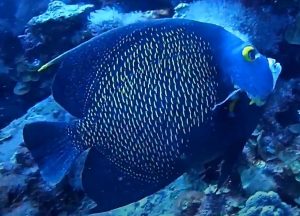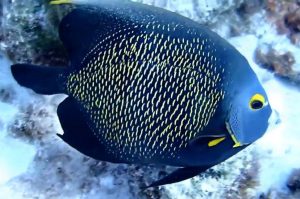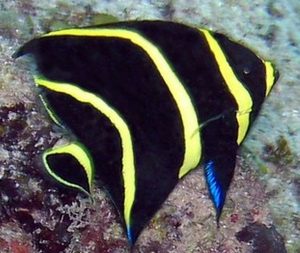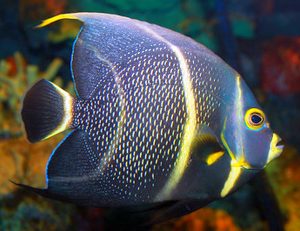The French Angelfish (Pomacanthus paru) known to tropical fish keeping enthusiasts as the French Angel or Black Angelfish is found in tropical western Atlantic waters along the coasts of North and South America from New York, through the Carolinas, down to Brazil; and the Gulf of Mexico, the Caribbean; and the Antilles. It is also found in the eastern Atlantic in the area of Ascension Island and St. Paul’s Rocks.
French Angelfish (Pomacanthus paru) frequent relatively shallow coral and rocky reefs where they can be seen singly or in pairs grazing on sponges, algae, corals, bryozoans, zoantharians, gorgonians, and tunicates.
Despite their large size, French Angelfish seldom venture deeper than 15 feet; often in the vicinity of sea fans, however, they have been reported at depths between 9 to over 300 feet.
French Angelfish are highly territorial and will aggressively defend their territories from other angelfish, among other species. Adult French Angelfish are monogamous and are almost always found in pairs grazing on the reef or defending their territory.
Juveniles Pomacanthus paru are often found in channels, bays, and along the inshore reefs where they establish cleaning stations and perform as cleaner fish, removing ectoparasites from a wide range of other fish species.
French Angelfish are active during the daylight hours, but like other reef dwellers seek shelter in a designated hiding spot where they return every night.
Adult French Angelfish have a dark dusky blue black body color with yellow scale margins that extend along the sides, around the eyes, and up to the dorsal fin. They have a pale dusky blue face with eyes ringed in bright yellow and mouth rimmed in white. The base of the pectoral fin, lower gill cover, and trailing tip of the dorsal fin is highlighted in yellow.
The French Angelfish is a protogynous hermaphrodite; females can change their sex to become a male when no male is present. There is no reliable way to determine the differences between males and females.
Juvenile French Angelfish have three vertical yellow bands over a black body background. As they grow, the
yellow bands break up into the dappled appearance of the adults. Juveniles are often misidentified as other species.
Because of their large size and the fact that they are not reef friendly, juvenile French Angelfish are best housed in a large fish only live rock (FOLR) aquarium of at least 100 gallon capacity with copious amounts of aged live rock for grazing and arranged into hiding places. Adults require a tank of at least 250 gallon capacity, preferably larger.
French Angelfish will quickly dominate a tank and pick at soft and stony corals, clam mantles, other crustaceans in the tank, and smaller fish. Although some tropical fish keeping enthusiasts have managed to successfully house them with Cladiella spp., Lamnalia spp., Litophyton spp., Sinularia spp. and other sturdy corals that produce a noxious chemical defense, reef tanks are not recommended.
Potential tank mates for French Angelfish are Blennies, Rabbitfish, Butterflyfish, Wrasses, Surgeonfish, and Triggerfish. Slow moving or sedentary fish, especially if they resemble a rock, coral, sponge, or anything like food, should be avoided.
French Angelfish have been bred in an aquarium environment. In the wild breeding takes place from April to September. Shortly before dawn, bonded pairs move to the deepest parts of the reef and chase each other around in short bursts. The pair will rise up into the water column and swim with their vents almost together until the female releases her eggs and the male, his sperm close to the surface. A single female will produce anywhere from 25,000 to 75,000 eggs each time she breeds. The fertilized eggs drift with the current and hatching around 20 hours later. The fry remain with the plankton until they reach approximately 15mm in length, and then drift down to the bottom of the reef.
In their natural environment, French Angelfish graze on algae, sponges, bryozoans, zoantharians, gorgonians, hydroids, corals, and tunicates. In an aquarium environment they should be provided with plenty of aged live rock to graze on with Spirulina, marine algae, an occasional high quality frozen angelfish preparations with sponge matter, and Mysis
or frozen shrimp. They do best when fed small portions at least three times daily.
French Angelfish (Pomacanthus paru) are available online from a variety of tropical fish keeping suppliers at the following approximate purche sizes; Juvenile Small 1″ to 1 1/2″; Medium 1 1/2″ to 2 1/4; Adult Small: 3″ to 3-1/2″; Medium: 4″ to 5″; Large: 6-1/2″ to 7″; Extra Large: 7″ to 7-1/2″
Prices range from under $250.00 to over $500.00 for large adults.
Minimum Tank Size: 250 gallons
Aquarium Type: Mature live rock
Care Level: Moderate
Temperament: Semi-Aggressive
Aquarium Hardiness: Hardy
Water Conditions: 72 °F – 78 °F, dKH 8 to 12, pH 8.1 – 8.4, sg 1.020-1.025
Max. Size: 24″
Color Form: Blue, Yellow, White
Diet: Omnivore
Compatibility: Not reef safe
Origin: Western Atlantic Florida to Brazil; Gulf of Mexico; Caribbean Sea
Family: Pomacanthidae
Lifespan: 10-15 years
Aquarist Experience Level: Expert






